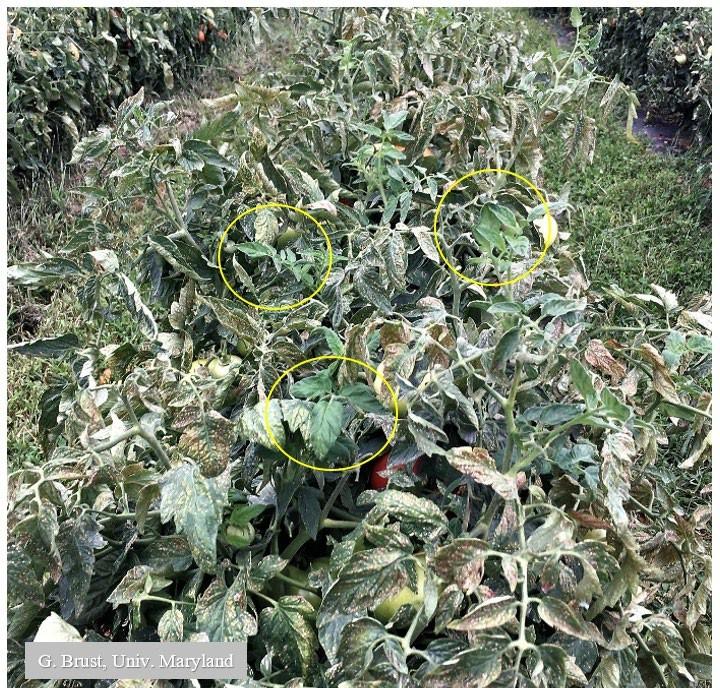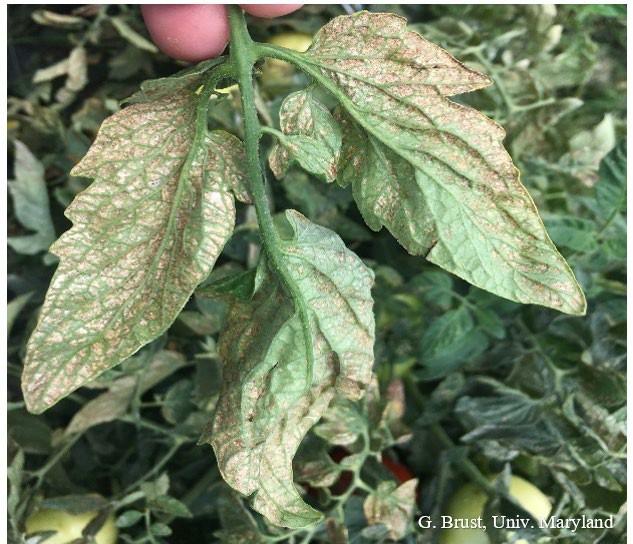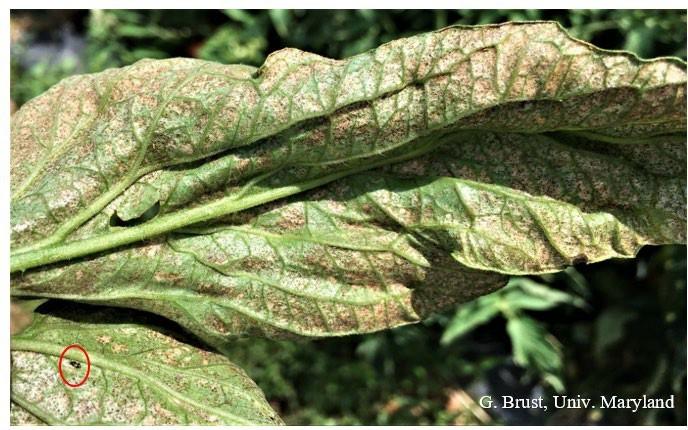
Over the past few weeks I have gotten reports of and have seen vegetable (mostly tomato, but also pepper crucifers, cucurbits and small fruit) fields throughout the Mid-Atlantic having problems with thrips (fig. 2). There are several species of thrips that are causing the problem in vegetables with the most common being the Eastern flower thrips, Frankliniella tritici, Tobacco thrips Frankliniella fusca, Western flower thrips, F. occidentalis and Onion thrips Thrips tabaci. The last three species are the ones most likely to transmit tomato spotted wilt virus (TSWV). In the fields I have been in that are having problems the thrips species have mostly been onion thrips and Western flower thrips.


Thrips are tiny, thin yellowish-orange insects the size of metal filings with fringed wings. They feed by puncturing the outer layer of plant tissue and sucking out the cell contents, which results in stippling-mild feeding damage or brown spots about 1/8 inch in size, which indicates heavy feeding damage (fig. 3). In some fields I was in the damage was so severe leaves had only about 25% green tissue left as the small feeding areas turned into large regions of dead tissue (fig. 3). These heavily fed upon areas are almost always accompanied by tiny black flecks of frass on the damaged areas of the underside of the leaf (fig. 4). Thrips hatch from an egg and develop into two larval stages and then the ‘prepupa and pupa’ stages, before becoming an adult. Females lay their kidney-shaped eggs into plant tissue. Thrips have several generations (up to eight) a year. When the weather is hot, the life cycle may be as short as 2 weeks.
Besides the physical damage to leaf and plant tissue several of the thrips can transmit TSWV (Western flower thrips are good at it while Onion thrips and Tobacco thrips are not quite as good at it and Eastern flower thrips cannot transmit the virus). Tomato spotted wilt virus is an obligate parasite, e.g., it must have a living host and must be moved from one plant to another by thrips or through cuttings or possibly seed. This disease can affect tomato and other Solanaceae crops as well as lettuce, beans, cucumber and 170 other plant species. It may take 2-4 weeks after thrips feed on a plant to see symptoms appear. Because of this TSWV appears to spread and worsen in plantings over time.
We were finding fields back in June that had TSWV problems which indicates to me the thrips problem was coming from the transplant house. Over the last 10 years my research has shown that at times 25-60% of transplants can have thrips eggs or larvae on them. It used to be that most of these hitchhikers on transplants would die in the field being unable to make the transition from the transplant production house out into the field environment. But that has changed and we are seeing more and more early infestations in vegetable fields. It also was found that treating your transplants with two applications of a 0.5-1% horticulture oil spray 1-2 weeks before transplanting to the field could reduce early season infestations by 70-80%.
At this time growers only want to know one thing and that is what can I spray to get rid of the thrips. I am afraid that there are no easy answers. Our best controls for thrips are the spinosyns, spinosad or spinetoram, but by this time most growers have used these products for several applications and need to change the mode of action. Some growers have found success using Torac in rotation with a neonicotinoid. One grower actually used the spinosyns because they had not used them this growing season and they worked very well. Other growers used Venom in rotation with Endigo and were able to reduce a severe outbreak of thrips. The problem is thrips or even two spotted spider mite outbreaks usually will not be managed with silver bullet chemicals and we need to rely on preventive management tactics for control. Using horticultural oils early in the season (May and early June) to reduce thrips populations would also help as it would reduce the possibility of resistance starting when using spinosyns or other insecticides for thrips control and the weather conditions at this time reduce the possibility of phytotoxic problems with using oils. The trick with oils is to achieve thorough coverage of the foliage, both the topside and underside of leaves must be covered with oil to be effective. Organic growers can use Entrust which is spinosad which will give good control of thrips unless it has been used often. If so, then a rotation of insecticidal soap with hort oils could be used.
Biological control agents work best in greenhouse situations and have had mixed results in high tunnel conditions, they are not recommended at this time for field applications as this would be too expensive and the results too inconsistent. One of the best predators of thrips is Orius insidiosus the insidious flower bug. I was amazed to see not only the adult (fig. 4 circle) in one heavily infested thrips field that had been sprayed weekly but also immatures. If we can find ways to increase these natural enemies in a field earlier in the season we may be able to avoid heavy infestations of thrips. Beauveria bassiana, an entomopathogenic fungus that attacks thrips can reduce thrips problems before they get started by applying weekly applications very early on in the season, but once it gets hot in June and July it does not work as well. Orius would not be too adversely affected if Beauveria bassiana or hort oils were used.
Return to Horticulture and Disease Topics
This article appears on August 19, 2021, Volume 12, Issue 5 of the Vegetable and Fruit News
Vegetable and Fruit News, August 2021, Vol. 12, Issue 5
Vegetable and Fruit News is a statewide publication for the commercial vegetable and fruit industries and is published monthly during the growing season (April through October). Subscribers will receive an email with the latest edition.
Subscribe